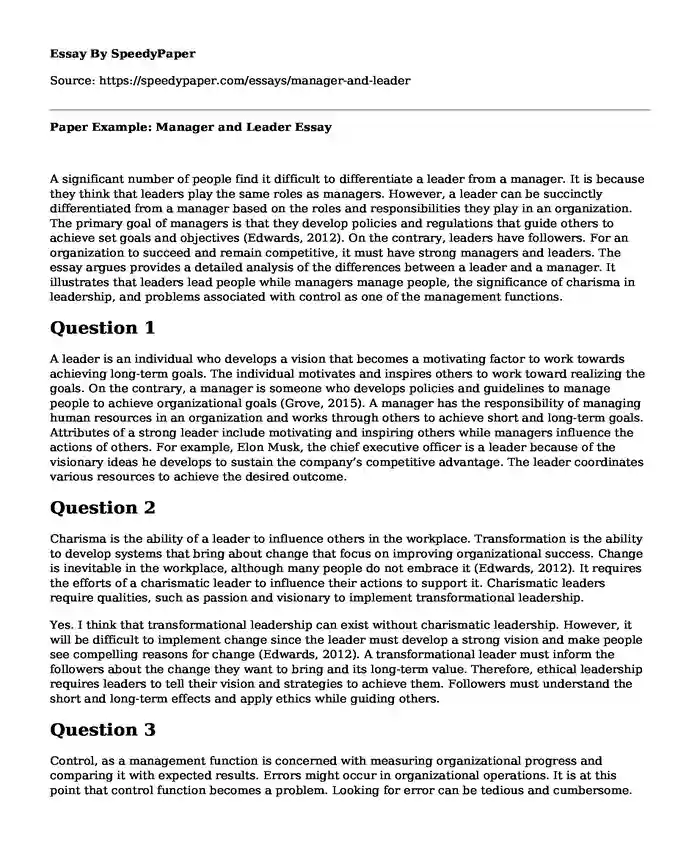
| Essay type: | Compare and contrast |
| Categories: | Leadership analysis Management Comparative literature |
| Pages: | 3 |
| Wordcount: | 631 words |
A significant number of people find it difficult to differentiate a leader from a manager. It is because they think that leaders play the same roles as managers. However, a leader can be succinctly differentiated from a manager based on the roles and responsibilities they play in an organization. The primary goal of managers is that they develop policies and regulations that guide others to achieve set goals and objectives (Edwards, 2012). On the contrary, leaders have followers. For an organization to succeed and remain competitive, it must have strong managers and leaders. The essay argues provides a detailed analysis of the differences between a leader and a manager. It illustrates that leaders lead people while managers manage people, the significance of charisma in leadership, and problems associated with control as one of the management functions.
Question 1
A leader is an individual who develops a vision that becomes a motivating factor to work towards achieving long-term goals. The individual motivates and inspires others to work toward realizing the goals. On the contrary, a manager is someone who develops policies and guidelines to manage people to achieve organizational goals (Grove, 2015). A manager has the responsibility of managing human resources in an organization and works through others to achieve short and long-term goals. Attributes of a strong leader include motivating and inspiring others while managers influence the actions of others. For example, Elon Musk, the chief executive officer is a leader because of the visionary ideas he develops to sustain the company’s competitive advantage. The leader coordinates various resources to achieve the desired outcome.
Question 2
Charisma is the ability of a leader to influence others in the workplace. Transformation is the ability to develop systems that bring about change that focus on improving organizational success. Change is inevitable in the workplace, although many people do not embrace it (Edwards, 2012). It requires the efforts of a charismatic leader to influence their actions to support it. Charismatic leaders require qualities, such as passion and visionary to implement transformational leadership.
Yes. I think that transformational leadership can exist without charismatic leadership. However, it will be difficult to implement change since the leader must develop a strong vision and make people see compelling reasons for change (Edwards, 2012). A transformational leader must inform the followers about the change they want to bring and its long-term value. Therefore, ethical leadership requires leaders to tell their vision and strategies to achieve them. Followers must understand the short and long-term effects and apply ethics while guiding others.
Question 3
Control, as a management function is concerned with measuring organizational progress and comparing it with expected results. Errors might occur in organizational operations. It is at this point that control function becomes a problem. Looking for error can be tedious and cumbersome. The causes of these problems include challenges in developing quantitative standards and employee resistance. The third factor is the cost of investigating a problem because a problem might be associated with external factors managers does not have control (Alvolio & Yammarino, 2013). Therefore, competent managers must possess skills and expertise to control organizational operations smoothly without paralyzing other activities.
Conclusion
The paper looked at differences between a manager and a leader. A leader creates a vision while managers create goals to realize long-term goals. Also, transformational leadership can exist without charismatic behavior but it will be difficult to implement change if there is no support from the followers. The control function is problematic for many managers due to the challenges of developing quantitative standards, employee resistance, and the inability to control external factors.
References
Alvolio, B., & Yammarino, F. (2013). Transformational and Charismatic Leadership: The Road Ahead 10th Anniversary Edition. Emerald.
Edwards, E. R. (2012). Charisma and the fictions of Black leadership. Universityof Minnesota Press.Grove, A. S. (2015). High output management. Vintage Books.
Cite this page
Paper Example: Manager and Leader. (2023, Oct 29). Retrieved from https://speedypaper.com/essays/manager-and-leader
Request Removal
If you are the original author of this essay and no longer wish to have it published on the SpeedyPaper website, please click below to request its removal:
- Project Management Essay Sample
- Essay Sample on Why Australian Banks Came Out Strong from the Global Financial Crisis
- Essay Sample Dedicated to Voices in Black America: Douglass and Hammon
- Free Essay: Analysis of Malaysian and Singaporean Domino Pizza Advertisements
- Free Essay Example on Janis Joplin
- Free Essay Example - Equiano and Douglas
- Time Value of Money: Exploring the Concept of Finance - Essay Sample
Popular categories




